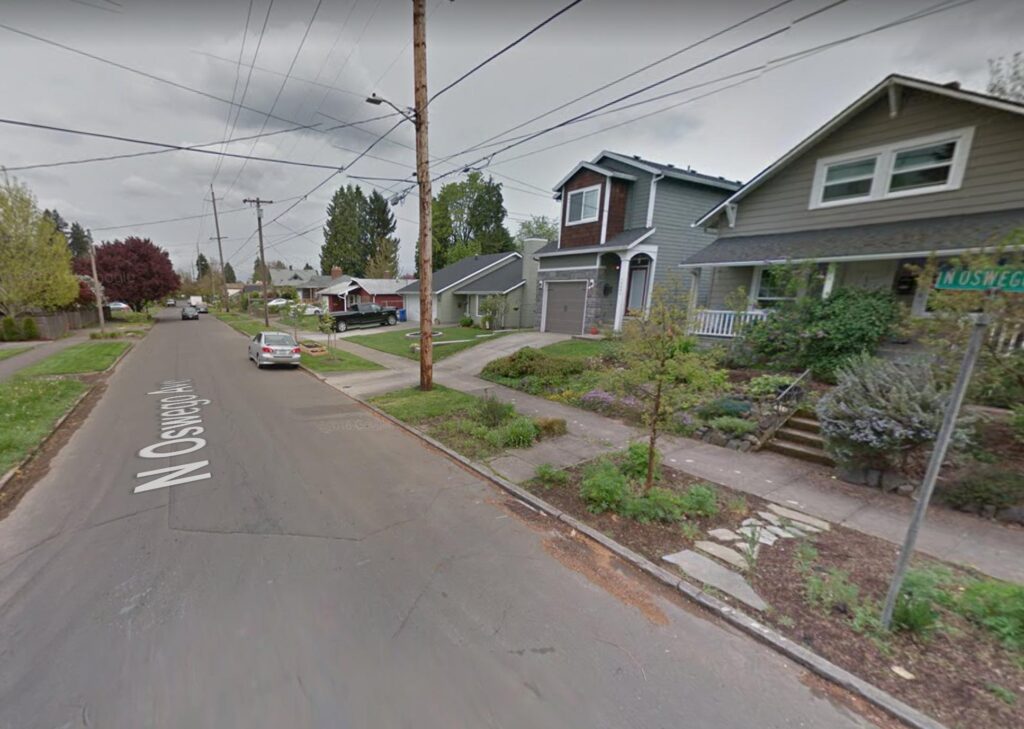It’s easy to jump to the conclusion that biking to daily tasks is too time consuming. To add to that, biking is slower speed than driving so it feels like travel is constrained for limited amount of time.
We did a quick Travel Time app analysis to see which daily tasks (grocery, childcare/daycare, elementary school, gym, coffee shop, restaurant, hair salon/barber shop) are within a twenty-minute bike ride for three randomly chosen locations in the Portland Metropolitan area. We selected areas that are not immediately adjacent to urban retail. It was assumed that travel was at 5pm on a weekday for a worst-case traffic analysis.
Location #1: Foster-Powell Neighborhood in Portland, Oregon
The current-day Foster Road was originally a pathway for indigenous people (such as the Chinook, Cowlitz, and Clackamas) to travel between the Willamette River and Johnson Creek. In the 1800s, the area transitioned to farmland and homesteads and the road was named after Phillip Foster, one of Portland’s pioneers.
Today, Foster-Powell, has transitioned into a triangle-slice of Portland with pockets of residential housing with Old Portland feel as well as some newer homes. The neighborhood’s residents include immigrants from Russia, Ukraine, Asia, and Latin America contribute to a vibrant community with diverse restaurants and a large concentration of sports bars.
In the image below, the Foster-Powell neighborhood 20-minute biking radius (pink) is smaller than the driving radius (blue), but there were many options for all categories (grocery, childcare/daycare, elementary school, gym, coffee shop, restaurant, hair salon/barber shop) considered. Childcare was the only category that was limited to three options at the time of this post.



Location #2: St. Johns Neighborhood in Portland, Oregon
In the 1800s, St. Johns was a sleepy town nestled at the intersection of the Columbia and Willamette rivers. The only way to get from St. Johns to Portland was by steam streetcar. The town was named for one of the earliest settlers, James John, who operated a ferry between St. Johns and Linnton.
Today, St. Johns still has a tight-knit community feel. The neighborhood historical monuments make the small-town neighborhood feel distinct within larger Portland. The neighborhood is highly residential and has beautiful views of the St. Johns Bridge and Cathedral Park. within the larger city.
In the image below, the St. Johns’ neighborhood 20-minute biking radius (pink) is smaller than the driving radius (blue) but driving adds limited areas of interest, mostly industrial. There were many options for all categories (grocery, childcare/daycare, elementary school, gym, coffee shop, restaurant, hair salon/barber shop) considered in the biking radius.



Location #3: West Neighborhood in Beaverton, Oregon
What is today the city of Beaverton, was originally home to the Atfalati Native Americans who settled the Tualatin valley. They setup a village at the Beaverton and Fanno creeks which translated as “place of the beaver.”
In the 1800s, western settlers transitioned the area to a small community of farms, grist mills, and manufacturing of logging products and the town name changed to Beaverton. Over time, the residential area has grown significantly with additions of high-tech and consumer industry.
In the image below, the West neighborhood of Beaverton 20-minute biking radius (pink) is smaller than the driving radius (blue) but covers a considerable number of areas with retail. There were many options for all categories (grocery, childcare/daycare, elementary school, gym, coffee shop, restaurant, hair salon/barber shop) in the biking radius.


All three residential locations analyzed offered many options for daily tasks within a twenty-minute bike ride.
In many cases, the closest option for a category was less than twenty minutes. The one area that we could not objectively capture was place of work since this is dependent on industry as well as individual choices.
We encourage you to do a similar analysis for your location and customize the travel time and locations for your lifestyle. You can use the data to better visualize your options and decide when and where it makes sense to bike instead of drive. Of course, time isn’t the only variable to consider; in future posts we’ll also look at safety and comfort.
Leave a Reply